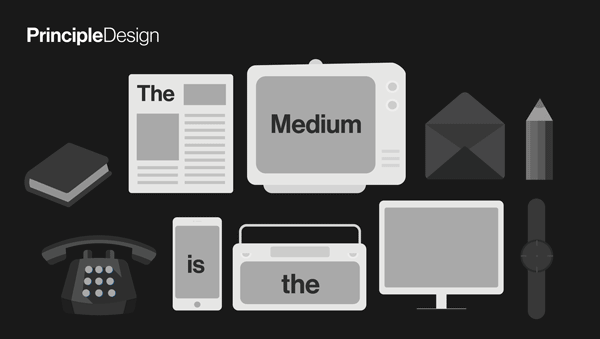The Medium is the Message
How McLuhan’s Wise Words Relate to Marketing
Before diving into this article, we recommend you watch BBC Radio 4’s excellent short video, coupled with the dulcet tones of Gillian Anderson, as narrator.
Over fifty years ago, McLuhan coined the phrase ‘The Medium is the Message’. In his writings, he posited that the means with which we consume information—what device we use to send and receive a message—is more significant than the information itself. For example, the invention of the telephone holds more criticality than any subsequent phone call made using the appliance. This theory applies to print, television, radio, and the many scaffolds of communication that take shape over the internet.
McLuhan explains that evolving mediums are so important because they change how we communicate, which leads to shifts in society. This shift can be something small, for example, a change in how we use language (such as saying the acronym “lol” in verbal rather than written speech). But it can also lead to more significant changes, including to our physiology — McLuhan refers to how humans switched from being aural communicators, and thus having excellent hearing, to much more visual animals after the introduction of print.
When promoting your brand the content still matters but, if the medium is the message, then it means your chosen medium will drive your content. With so many digital platforms to tell your brand’s story, how do you decide which medium is best to get your message across? Let’s talk through a few channels with which your Brand might come into contact.
Social Media | The Personality Medium
In his book, McLuhan prophetically spoke about technology and communication as having the potential to create a “global village”. Social media platforms like YouTube, Twitter, and Instagram could be considered the public parks and recreation centres of McLuhan’s global village — a place where people go to ‘hang out’ with their friends. The 2015 Sensis Social Media Report confirms this, claiming that 92 per cent of people are on social media to catch up with mates.
As the name suggests, the best way for B2B models to be successful on these platforms is to be social. Think like a friend. It’s a place to be more candid, to share a bit about your work culture, celebrate your team and their work, and hone in on your brand’s personality.
Video | The Emotive Medium
Immersive storytelling is part of what makes video formats so appealing. It’s an accessible escape from everyday life, one which often feels less arduous and time-consuming than reading text. We can insulate ourselves in the intimate confines of someone else’s skin, and steep ourselves in other worlds, all with the simple click of a button.
Video stimulates emotions such as empathy and excitement which, when related to your brand, can help enhance your brand’s perception by association. Driving emotion is also a pivotal way to create engagement. What’s more, video is eye-catching and thus a great accompaniment to text (text propels SEO while video drives emotion).
Website | The Informative Medium
Continuing with the theme of McLuhan’s “global village”, consider your brand’s website as your home base. You want to create a space for ‘guests’ that’s easy to find and that feels inviting once they arrive.
It’s crucial to write with the users’ search intention in mind. Over half your traffic will hit your website through organic searches, so structuring it for SEO will help guide the right people to your website (for more info on SEO and website design, see our handy article here). A study by BrightEdge found that paid search is responsible for less than 10 per cent website traffic, so it might not be wise to invest too heavily in this method.
In terms of content, give customers bite-sized morsels of information to assist with our waning attention spans. Write copy that’s well structured, making use of headings and bullet points which help readers scan for the information they are after. Maintain your posts, so they stay relevant, shaping your content to suit your goals as well as those of customers.
Including accompanying images and videos with your text, when appropriate, is like adding icing on a cake — presenting readers with a more polished offering and something they will more likely want to share with their peers.
The Medium is the Message, and Marketing
The channel, on which you promote your brand, holds responsibility for who sees your content. It also determines how long people spend observing or reading your work, and the significance, or weight, viewers will attach to each communication. For example, studies show that a magazine ad will have more impact on a person than, say, a YouTube banner ad. Therefore, the time, energy, and resources spent creating your content will very much depend on how it’s delivered to your audience.
When determining your desired results, carefully considering which medium to employ will help you deliver the right message to the right people. Whether you are looking to maximise brand reach and awareness, nurture the relationship with your current customers, or differentiate your product from your competitors, there is a medium that will suit your needs. It’s just about finding the right one!
Best wishes from our global village to yours,
PrincipleDesign

